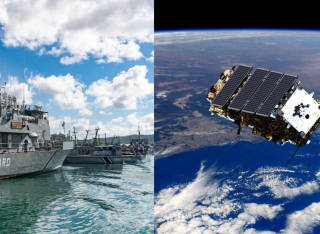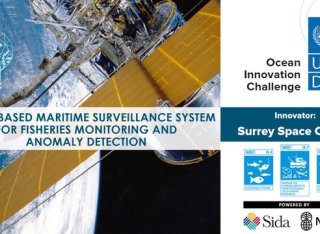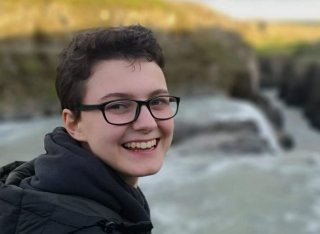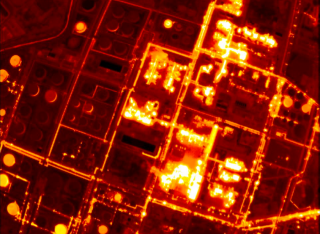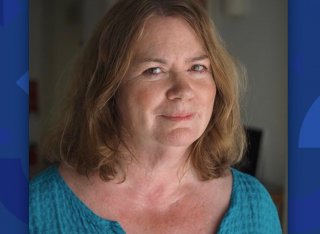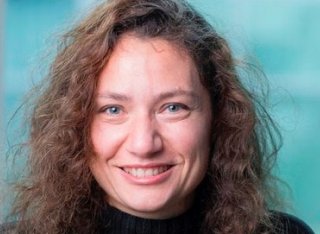
Dr Raffaella Guida
Academic and research departments
Surrey Space Centre, School of Computer Science and Electronic Engineering.About
Biography
Raffaella received the Laurea degree (cum laude) in Telecommunications Engineering and the Ph.D. degree in Electronic and Telecommunications Engineering from the University of Naples Federico II (Naples, Italy), in 2003 and 2007, respectively. In 2006, she received a two-year research grant from the University of Naples Federico II to be spent at the Department of Electronic and Telecommunication Engineering on the topic of electromagnetic field propagation in urban environment. In 2006, she was also a Guest Scientist with the Department of Photogrammetry and Remote Sensing, Technische Universität München (Munich, Germany). In 2008, Raffaella joined the Surrey Space Centre (SSC), University of Surrey (Guildford, U.K.) as a Lecturer in Satellite Remote Sensing. Today she is still in SSC as Reader and Head of the Remote Sensing Applications research group. Since September 2019 Raffaella is also PostGraduate Research Director in SSC.
Raffaella has published more than 80 papers and was awarded the IEEE J-STARS Best Paper Award 2013 for her research on statistical analysis of SAR data.
University roles and responsibilities
- PGR Director in Surrey Space Centre
- Member of the Faculty Research Degrees Committee (FRDC)
- Sustainability Fellow at the Institute for Sustainability
Affiliations and memberships
News
ResearchResearch interests
- Remote sensing and Earth Observation
- Synthetic Aperture Radar (SAR)
- Scattering models from natural and man-made targets
- Statistical models for SAR images
- Main applications: urban areas monitoring, natural disasters monitoring (flooding, earthquake, oil spill), deforestation, land use/land change, soil moisture, crops classification, maritime surveillance
- High resolution thermal data
Research collaborations
Raffaella has a huge network of international collaborations with universities, space agencies, space and remote sensing companies and non-governmental organizations.
PhD programme
Earth observation
- Urban areas monitoring with high resolution SAR images
- UK forests monitoring with optical, infrared and radar imagery
- Maritime surveillance
- SAR and AIS data association
- Satellite Data quality assessment
- Soil moisture
- Remote sensing data fusion.
Disaster monitoring
- Detection of flooded areas with optical and SAR images
- Detection of damaged urban areas after earthquake in SAR images
- Scattering models for oil spill weathering processes.
Technology
- S-band SAR
- In-orbit assembly SAR.
Requirements
You hold a first class honours degree in engineering, physics or maths. You have knowledge of remote sensing and interest in Earth observation and disaster monitoring, together with familiarity with at least one of the following fields:
- Electromagnetics
- Image processing
- Geographical information systems (GIS).
Creative and hard-working profiles are particularly encouraged.
Other skills
Experience with IDL and/or ENVI software is an advantage.
Research interests
- Remote sensing and Earth Observation
- Synthetic Aperture Radar (SAR)
- Scattering models from natural and man-made targets
- Statistical models for SAR images
- Main applications: urban areas monitoring, natural disasters monitoring (flooding, earthquake, oil spill), deforestation, land use/land change, soil moisture, crops classification, maritime surveillance
- High resolution thermal data
Research collaborations
Raffaella has a huge network of international collaborations with universities, space agencies, space and remote sensing companies and non-governmental organizations.
PhD programme
Earth observation
- Urban areas monitoring with high resolution SAR images
- UK forests monitoring with optical, infrared and radar imagery
- Maritime surveillance
- SAR and AIS data association
- Satellite Data quality assessment
- Soil moisture
- Remote sensing data fusion.
Disaster monitoring
- Detection of flooded areas with optical and SAR images
- Detection of damaged urban areas after earthquake in SAR images
- Scattering models for oil spill weathering processes.
Technology
- S-band SAR
- In-orbit assembly SAR.
Requirements
You hold a first class honours degree in engineering, physics or maths. You have knowledge of remote sensing and interest in Earth observation and disaster monitoring, together with familiarity with at least one of the following fields:
- Electromagnetics
- Image processing
- Geographical information systems (GIS).
Creative and hard-working profiles are particularly encouraged.
Other skills
Experience with IDL and/or ENVI software is an advantage.
Supervision
Completed postgraduate research projects I have supervised
Primary supervision
- Max Rodger, July 2017 – October 2021, PhD Award.
- Salvatore Savastano, September 2015 – March 2020, PhD Award.
- Oualid Yahia, April 2015 – October 2019, PhD Award.
- Abdelhakim Benoudjit, April 2015 – September 2019, PhD Award.
- Pasquale Iervolino, July 2012 – January 2016, PhD Award.
- Salman S.Khan, October 2009 – July 2013, PhD Award.
- Peter T.B.Brett, July 2009 – July 2013, PhD Award.
Teaching
- Satellite Remote Sensing EEEM033
- Electrical Science II EEE2045 (Part B on Electromagnetism)
For her excellence in teaching and keen attitude to introduce new teaching methodologies, Raffaella was awarded the Teaching with New Technologies (TeNT) Award by University of Surrey in 2008.
Sustainable development goals
My research interests are related to the following:






Publications
The monitoring of ships which do not report their Automatic Identification System (AIS) information is important for Maritime Domain Awareness (MDA). In this paper, an improved maritime picture is generated by presenting a new methodology to map these so-called 'dark' ships over time. Firstly, a robust and accurate data association between Synthetic Aperture Radar (SAR) ship detections and AIS data is carried out on multi-temporal SAR imagery and AIS data. Subsequently, Kernel Density Estimation (KDE) is applied to unassigned SAR ship detections to reveal the spatial distribution of `dark' zones (i.e. areas where repeated unassignments occur). This analysis helps identify areas where ships frequently do not report, which can help guide authorities in the best way to respond. The methodology is validated using Sentinel-1 Interferometric Wide (IW) swath mode products and AIS data acquired from the English Channel, UK.
The United Nations Development Programme (UNDP) launched the Ocean Innovators program to combat illegal fishing and destructive fishing practices, benefiting Small Island Developing States (SIDS) and Least Developed Countries (LDCs). One of the selected projects, 'Nereus', currently being developed by Surrey Space Centre (SSC) and Mauritius Research and Innovation Council (MRIC), utilises AI and satellite data fusion to monitor fishing vessel activity in Mauritius' Exclusive Economic Zone (EEZ) and Marine Protected Areas (MPAs). The project combines various satellite technologies, including Synthetic Aperture Radar (SAR), Automatic Identification System (AIS) and Vessel Monitoring System (VMS). This paper analyses multi-temporal SAR and AIS data to identify "dark" ships that are not transmitting AIS signals. The methodology is applied to the Mauritius EEZ and MPAs, providing authorities with valuable information for informed decision-making and effective Maritime Domain Awareness (MDA).
The use of multi-temporal Synthetic Aperture Radar (SAR) imagery to assess damage caused by directed attacks in conflict zones is explored. This paper focuses on the Russia-Ukraine war as an example and emphasises the need for a reliable method to measure damage to urban infrastructure. The study presents a methodology that utilises a technique called Coherent Change Detection (CCD) using SAR imagery from Sentinel-1 to assess damaged areas in the city of Mariupol, Ukraine. The authors acquired SAR images before and after an artillery shelling event and measured the change in coherence between these images to assess the damage. They also compared the SAR results with contextual information from media reports and community-based projects to validate the findings. The paper provides specific examples of damage level classification maps for various types of infrastructure, such as a metallurgical factory, shopping mall and a maternity hospital. The results show good visual correlation between the bomb impact locations and the severity of damage. The authors conclude that multi-temporal SAR can complement other sensors in damage assessment mapping, especially in adverse weather conditions. Future work will focus on improving the damage assessment index and validating the damage level thresholds.
GNSS Reflectometry (GNSS-R), a method of remote sensing using the reflections from satellite navigation systems, was initially envisaged for ocean wind speed sensing. In recent times there has been significant interest in the use of GNSS-R for sensing land parameters such as soil moisture, which has been identified as an Essential Climate Variable (ECV). Monitoring objectives for ECVs set by the Global Climate Observing System (GCOS) organisation include a reduction in data gaps from spaceborne sources. GNSS-R can be implemented on small, relatively cheap platforms and can enable the launch of constellations, thus reducing such data gaps in these important datasets. However in order to realise operational land sensing with GNSS-R, adaptations are required to existing instrumentation. Spaceborne GNSS-R requires the reflection points to be predicted in advance, and for land sensing this means the effect of topography must be considered. This paper presents an algorithm for on-board prediction of reflection points over the land, allowing generation of DDMs on-board as well as compression and calibration. The algorithm is tested using real satellite data from TechDemoSat-1 in a software receiver with on-board constraints being considered. Three different resolutions of Digital Elevation Model are compared. The algorithm is shown to perform better against the operational requirements of sensing land parameters than existing methods and is ready to proceed to flight testing.
In the field of maritime surveillance with satellite imagery, ship detection with Synthetic Aperture Radar (SAR) is largely successful with the exception of those cases where the target Radar Cross Section (RCS) results very low and hard to detect. The paper presents an automatic algorithm that tackles the problem of ship detection in situations where the ship's RCS is not measurable but its wake is. At this purpose, the algorithm proposed uses a combination of image processing techniques in order to identify ships exclusively by detecting the wakes they leave behind. Once a ship is identified through its wake, its position in the image, its heading and its speed are determined. The algorithm was developed, tested and validated on SAR imagery from the European Space Agency mission Sentinel-1; the results are here presented and discussed. The algorithm was validated on a total of 43 images and resulted in a ship detection rate of 93% with wakes' components recognized in more than 80% of the cases analysed.
The hybrid stripmap/spotlight mode for a synthetic aperture radar (SAR) system is able to generate microwave images with an azimuth resolution better than the one achieved in the stripmap mode and a ground coverage better than the one of the spotlight mode. In this paper, time- and frequency-domain-based procedures to simulate the raw signal in the hybrid stripmap/spotlight mode are presented and compared. We show that a two-dimensional Fourier domain approach, although highly desirable for its efficiency, is not viable. Accordingly, we propose a one-dimensional (1-D) range Fourier domain approach, followed by 1-D azimuth time-domain integration. This method is much more efficient than the time-domain one, so that extended scenes can be considered. In addition, it involves approximations usually acceptable in actual cases. Effectiveness of the simulation scheme is assessed by using numerical examples.
Ship detection with synthetic aperture radar (SAR) images, acquired at different working frequencies, is presented in this paper where a novel technique is proposed based on the generalized-likelihood ratio test (GLRT). Suitable electromagnetic models for both the sea clutter and the signal backscattered from the ship are considered in the new technique in order to improve the detector performance. The GLRT is compared to the traditional constant false alarm rate (CFAR) algorithm throughMonte–Carlo simulations in terms of receiver operating characteristic (ROC) curves and computational load at different bands (S-, C-, and X-). Performances are also compared through simulations with different orbital and scene parameters at fixed values of band and polarization. The GLRT is then applied to real datasets acquired from different sensors (TerraSAR-X, Sentinel-1, and Airbus airborne demonstrator) operating at different bands (S-, C-, and X-). An analysis of the target-to-clutter ratio (TCR) is then performed and detection outcomes are comparedwith an automatic identification system data when available. Simulations show that the GLRT presents better ROCs than those obtained through the CFAR algorithm. On the other side, results on real SAR images demonstrate that the proposed approach greatly improves the TCR (between 22 and 32 dB on average), but its computational time is 1.5 times slower when compared to the CFAR algorithm.
In the last years a new feature extraction approach from a single amplitude SAR image of urban areas has been introduced by the authors. In this paper they discuss the feasibility of this approach to detect changes in urban areas when natural hazards occur, with the aim to identify damaged or collapsed buildings by monitoring changes in the radiometric content of relevant SAR images. The test is performed on COSMO-SKyMed data provided before and after the earthquake that took place in the area around L¿Aquila, Italy, in April 2009. First results are presented and discussed.
Nowadays, monitoring and management of built-up areas is becoming a crucial endeavor for all civil and politic communities. In the upcoming future, important contributions to this matter will come from scientific community. In fact, new powerful spaceborne sensors for monitoring urban areas have been designed and are ready for launch. In particular, a Synthetic Aperture Radar (SAR) called TerraSAR-X with outstanding performance of resolution will be soon launched by the German Aerospace Center (DLR) [1]. Availability of more detailed SAR images could improve, at least in theory, human interpretation as more information is contained in the image itself. But the extraction of this both geometric and electromagnetic information, is still a hard task. With regards geometric features of urban areas, many steps have been done in building shape and dimensions retrieval and are widely documented in literature [2],[3]. But extraction concerning electromagnetic features of a building (i.e. dielectric constants of its parts) is not yet a concrete result even if it would be of paramount importance for the impact that a similar retrieval would have on applications. For example, let us think of the possibility of checking the presence of water infiltrations in building walls or of amianthus, widely employed in the past in building industry as insulating material but now forbidden by the law in many countries for its demonstrated carcinogenic properties. In this paper, capability of retrieving electromagnetic information from high resolution SAR images is inspected. To our aim, we need scattering models taking into considerations the electromagnetic properties of the building materials when the radar signal interacts with a building in the scene. Some empirical models have been developed for radar backscattering from soils, crops, forest vegetation etc., but for urban geometries they are still inadequate. Despite of this, a complete electromagnetic backscattering model for a canonical isolated structure placed on a rough terrain [4] is here employed in simulation examples. In order to foresee our future ability to retrieve electromagnetic information from high resolution SAR images of urban areas, some experiments have been jointly carried out by the remote sensing groups at the University of Naples (Italy) and the University of Munich (Germany). The test area is located in Munich and shows the buildings of Technische Universität and the Alte Pinakothek in the quarter of Schwabing. The radar functioning mode parameters that have been set are responsible for the high resolution got in the final SAR image which needs to be interpreted after being processed. In this paper, the authors first simulate, thanks to the availability of a Digital Elevation Model (DEM), the SAR raw signal relative to the same area illuminated during the flight campaign. In this first simulation only contributions of the first order to the backscattered signal are considered (i.e., single scattering) and no difference in materials or in soil roughness is taken into account. In this way, the attention mainly focuses on the geometrical properties of the scene and on their effects on the SAR image, which will be discussed at the conference. Subsequently, a different raw signal simulation has been realized in which only some buildings, with a particular electromagnetic behaviour, have been placed in the scene. Contributions to the backscattered field till the third order have been considered (i.e., single scattering, wall-ground and ground-wall double scattering, and wall-ground-wall triple scattering), but, to do this, some simplifications on the geometrical models needed to be accomplished according to the simulator requirements. On the other hand, in this way different materials could be assumed even for the same building, thus obtaining a more realistic simulation. The interested area has been visited several times to collect some samples of materials and achieve a better simulated representation of the area itself. Finally, the SAR simulated images are compared to the real one. Based on this comparison, some previously unexplained features of the real SAR image are satisfactorily interpreted. At the conference the authors will discuss the simulation-based interpretation of the considered SAR image, particularly analyzing the possibility to retrieve electromagnetic information about the buildings in the scene when a model-based approach is employed. The most interesting results will be widely inspected and presented. [1]Roth, R. Weninghaus “Status of the TerraSAR-X Mission”, IEEE International Geoscience and Remote Sensing Symposium (IGARSS) on CD. [2]M.Quartulli, M.Datcu, “Stochastic Geometrical Modeling for Built-Up Area Understanding from a Single SAR Intensity Image with Meter Resolution”, IEEE Trans. Geosc. Remote Sensing, vol.42, pp.1996 2003, 2004. [3]R.Bolter, “Reconstruction of Man-Made Objects from High Resolution SAR Images”, IEEE Aerospace Conference Proceedings, vol.3, pp.287-292, 2000. [4]G.Franceschetti, A.Iodice, D.Riccio, G.Ruello “SAR raw signal simulation for urban structures”, IEEE Trans. Geosc. Remote Sensing, vol.41, pp.1986 1995, 2003.
In this research the best techniques of fusion for near-contemporaneous Synthetic Aperture Radar (SAR) and Automatic Identification System (AIS) datasets are studied to simulate the expected performance from NovaSAR-1. Specifically , data association techniques are quantitatively compared by performing a series of Monte Carlo tests. The evaluation has been carried out using a satellite-based AIS dataset acquired from the English Channel on 07 June 2016, and SAR ship detections are simulated by reckoning the AIS dataset forward in time along a geodesic on a WGS84 reference el-lipsoid. Accurate data association is achieved using an m-best multidimensional assignment technique, which is consistent with being used in an operational environment, especially in high-density shipping areas.
Global navigation satellite system reflectometry (GNSS-R) has found many applications in the field of Earth observation including ocean wind-speed detection, ice altimetry, soil moisture monitoring, and more. The main focus of GNSS-R research to date has been on forward-scattered reflections, but theoretical work has proposed a backscattering regime and associated new application opportunities, including marine target detection. This article discusses the methods and results of processing the U.K. TechDemoSat-1 raw data collections in a backscattering regime for the first time, with initial results from sea ice datasets presented. The research has also identified a key problem with the backscatter method-for certain geometries the power from the specular point (forward scattered) may contaminate the data. The theory behind this and a method for predicting such occurrences is also discussed.
In this research the best techniques of fusion for near-contemporaneous Synthetic Aperture Radar (SAR) and Automatic Identification System (AIS) datasets are studied to simulate the expected performance from NovaSAR-1. Specifically, data association techniques are quantitatively compared by performing a series of Monte Carlo tests. The evaluation has been carried out using a satellite-based AIS dataset acquired from the English Channel on 07 June 2016, and SAR ship detections are simulated by reckoning the AIS dataset forward in time along a geodesic on a WGS84 reference ellipsoid. Accurate data association is achieved using an m-best multidimensional assignment technique, which is consistent with being used in an operational environment, especially in high-density shipping areas.
This paper presents a ship-detection study with Synthetic Aperture Radar (SAR) images acquired at two different frequencies: X- and C-band. The detection procedure relies on a novel algorithm based on the likelihood functions of both canonical ship target and sea clutter. Spaceborne images were acquired over the same area in the Solent Channel in UK at approximately the same time on the 7th June 2016. Here, datasets are compared in terms of probability of detection (PD), probability of false alarm (PFA) and Target-to-Clutter Ratio (TCR). Detection maps are validated with Automatic Identification System (AIS) data when available and preliminary results show a higher TCR for the X-band SAR image.
In the context of a flooding, a clear cloud-free SAR (Synthetic Aperture Radar) image proves mainly useful to retrieve flood features that can provide an extensive understanding of the disaster. Among these features, extremely important is the water depth on which this paper will focus by looking for a semi-automated algorithm for its estimation in the neighborhood of a given building from a pair of SAR images. In this study, two SAR images acquired during dry and flooded conditions are necessary, as well as a DSM (Digital Surface Model) to give an a priori knowledge of the height of the building and its footprint. The whole process is divided into two main parts: First, an extraction of the building’s double-bounce contribution using Genetic Algorithms, then the computation of the inundated building’s height, to eventually evaluate the water level locally in the neighborhood of this building. Thanks to the semi-automation of the double-reflection line retrieval, the execution time of the whole process was reduced from a few minutes (time to manually delineate the double-bounce line) to a few seconds, while keeping an error in the estimated flood depth in the order of a few decimeters (35cm on average).
The ${cal K}$ distribution can arguably be regarded as one of the most successful and widely used models for radar data. However, in the last two decades, we have seen tremendous growth in even more accurate modeling of radar statistics. In this regard, the relatively recent ${cal G}^{0}$ distribution has filled some deficiencies that were left unaccounted for by the ${cal K}$ model. The ${cal G}^{0}$ model, in fact, resulted as a special case of a more general model, the ${cal G}$ distribution, which also has the ${cal K}$ model as its special form. Single-look and multilook complex polarimetric extensions of these models (and many others) have also been proposed in this prolific era. Unfortunately, statistical analysis using the polarimetric ${cal G}$ distribution remained limited, primarily because of more complicated parameter estimation. In this paper, the authors have analyzed the ${cal G}$ model for its parameter estimation using state-of-the-art univariate and matrix-variate Mellin-kind statistics (MKS). The outcome is a class of estimators based on the method of log cumulants and the method of matrix log cumulants. These estimators show superior performance characteristics for product model distributions such as the ${cal G}$ model. Diverse regions in TerraSAR-X polarimetric synthetic aperture radar data have also been statistically analyzed using the ${cal G}$ model with its new and old estimators. Formal goodness-of-fit testing, based on the MKS theory, has been used to assess the fitting accuracy between different estimators and also between the ${cal G}$, ${cal K}$, ${cal - }^{0}$, and Kummer-${cal U}$ models.
GNSS reflectometry, whilst originally envisaged for ocean wind speed sensing, has recently been shown to be sensitive to land parameters such as soil moisture. Soil moisture is an important variable for many use cases including climate change monitoring, and as such there is a need to reduce gaps in datasets of this variable collected by satellites. By implementation on small platforms, GNSS-R missions can address this need, but current instrumentation must be updated to allow prediction of reflection points over the land surface. This paper presents an algorithm for achieving this along with results from both software testing and initial on-board implementation on DoT-1. These show that when Delay-Doppler maps are generated using the new algorithm the peak reflected power is successfully captured (in line with platform constraints) in 55% of software tests, compared with just 10% for the current method. Telemetry from DoT-1 shows that the algorithm has been successfully incorporated into the flight software. Future tasks to verify the on-board performance and improve the algorithm further are also discussed.
Kinematic characterization of a landslide at large, small, and detailed scale is today still rare and challenging, especially for long periods, due to the difficulty in implementing demanding ground surveys with adequate spatiotemporal coverage. In this work, the suitability of space-borne synthetic aperture radar sub-pixel offset tracking for the long-term monitoring of the Slumgullion landslide in Colorado (US) is investigated. This landslide is classified as a debris slide and has so far been monitored through ground surveys and, more recently, airborne remote sensing, while satellite images are scarcely exploited. The peculiarity of this landslide is that it is subject to displacements of several meters per year. Therefore, it cannot be monitored with traditional synthetic aperture radar differential interferometry, as this technique has limitations related to the loss of interferometric coherence and to the maximum observable displacement gradient/rate. In order to overcome these limitations, space-borne synthetic aperture radar sub-pixel offset tracking is applied to pairs of images acquired with a time span of one year between August 2011 and August 2013. The obtained results are compared with those available in the literature, both at landslide scale, retrieved through field surveys, and at point scale, using airborne synthetic aperture radar imaging and GPS. The comparison showed full congruence with the past literature. A consistency check covering the full observation period is also implemented to confirm the reliability of the technique, which results in a cheap and effective methodology for the long-term monitoring of large landslide-induced movements.
Change detection is one of the most addressed topics in the remote sensing community. When performed on synthetic aperture radar images, the most critical issues are as follows: 1) the labeling of the identified changing patterns and 2) the scarce robustness of classic pixel-based approaches based on threshold segmentation of an appropriate change index, which tend to fail when multiple changes are present in the study area. In this work, a new methodology for unsupervised change detection in vegetation canopy is presented. It overcomes these limitations by exploiting multitemporal geographical object-based image analysis with the aim to make the intrinsic semantic of data emerge and direct the processing toward the identification of precise classes of changes through dictionary-based preclassification and fuzzy combination of class-specific information layers. The proposed methodology has been tested in ten different experiments covering agriculture and clear-cut deforestation applications. The results, validated against literature methods, highlighted the superiority of the proposed approach, which was quantitatively assessed in terms of standard classification quality parameters. On agriculture experiments, it allowed for an average increase in the detection accuracy of about 11% with respect to the best performing literature method, with an increment of the false alarm rate in the order of 0.5%. In case of deforestation, the registered detection accuracy was comparable to that achieved by the literature, while the most significant benefit was the reduction, of more than one-third, of the number of detected false deforestation patterns. Overall, the main characteristics of the proposed architecture are the robustness and the lack of any supervision, which makes it very well-suited for operational scenarios.
The use of airborne Mid-Wave InfraRed (MWIR) imagery for maritime applications such as ship detection is evaluated for future spaceborne missions. A flight campaign was carried out on 30 October 2020 over the Solent (UK) to provide a dataset of airborne MWIR that was acquired at the same time as a spaceborne Synthetic Aperture Radar (SAR) product. The thermal infrared imagery is compared to SAR to determine its suitability for ship detection. Automatic Identification System (AIS) data was also acquired and used to both identify and validate the ship detections where available. The results indicate that high spatial resolution satellite thermal infrared imagery can be a useful data source for ship detection.
Most of the SAR missions of the latest years presented sensors working in X-band (like in the TerraSAR-X and Cosmo-SkyMed missions). Today new SAR missions, working at alternative frequencies like S-band, are under planning/design and will be launched in the upcoming years. In addition, full polarimetry is likely to be implemented in some of those missions. This is the case of the UK sensor NovaSAR-S to be launched by 2013. In order to validate the performance of S-band, especially in comparison with the better known and tested X-band, an airborne demonstrator has been set up to contemporaneously acquire fully polarimetric SAR data in both bands. In this paper we present, compare and discuss results deriving from the application of the H/α and the Pauli decompositions to the fully polarimetric datasets in both bands to understand possible advantages of S-band in specific applications.
A novel decision level data fusion algorithm for soil moisture content estimation is proposed in this paper. Firstly, individual estimations are determined, respectively, from the inversion of the Integral Equation Model (IEM) for Sentinel-1 and from the Temperature Vegetation Dryness Index (TVDI) for LANDSAT-8. Then, a feature level fusion of these methods is performed using an Artificial Neural Network (ANN). Finally, all estimations including the feature level fusion estimation are fused at the decision level using a novel weights based estimation. The area of interest for this study is Blackwell Farms, Guildford, United Kingdom and datasets were taken on 17/11/2017 for both Landsat-8 and Sentinel-1. Estimation from the proposed decision level fusion method produces a Root Mean Square Error RMSE (1.090%) which is lower than RMSE of the individual estimations of each sensor as well as that of the feature level fusion estimation.
The paper introduces a novel approach for ship-detection and ambiguity removal in images acquired from Synthetic Aperture Radar (SAR) operating in Low Pulse Repetition Frequency (LPRF) mode. The procedure consists of four steps. In the detection step, the bright clusters of pixels representative of the ships are isolated using a Constant False Alarm Rate (CFAR) algorithm; in the maximum selection step a pixel maximum in amplitude is chosen for each cluster; in the third step the isolated pixels are interpolated and, finally, the stationary point of the curve, corresponding to the actual position of the target, is computed. The algorithm is tested on an airborne S-band SAR image of the Solent in the United Kingdom.
Collection of ground truth to validate remote sensing classification and/or detection algorithms is rarely accounted for due to the inaccessibility of the sites or the elevated costs of such operations. In this paper some of the opportunities behind crowd sourcing are explored through the description of a remote sensing project on water quality monitoring in Africa where the ground truth was collected involving and training people from local communities.
The feasibility of azimuthal Time-Frequency (TF) analysis for urban area identification using TerraSAR-X (TX) fully polarimetric data has been investigated for the first time. Space-borne sensors, unlike airborne sensors, are characterized by a very small azimuth antenna aperture, which limits the Sub-Aperture (SA) decomposition in the azimuth direction. Due to this limitation, the usefulness of SA decomposition for space-borne sensors, has still not been explored. Pixel stationarity, which generally has lower values over urban areas, has been measured for TX data. It has been found that the full doppler spectrum has to be utilized for TX to generate a meaningful stationarity pixel map from SA coherency matrices. This analysis has been performed on TX fully polarimetric data acquired in April, 2009 over a site called Wallerfing in Germany.
Recently, a new operating mode for Synthetic Aperture Radar (SAR) system, referred to as hybrid stripmap/spotlight mode, has been presented [1-2]. In the hybrid acquisition mode the radar antenna beam is steered about a point farther away from the radar than the area being illuminated, thus generating microwave images with an azimuth resolution better than that achieved in the stripmap configuration, and a ground coverage better than the one of the spotlight configuration. The subject of design, processing and data interpretation for the hybrid SAR mode is gaining an increasing interest in the remote sensing scientific community. Consequently, a hybrid SAR raw signal simulator is strongly required, especially when real raw data are not available yet, to test processing algorithms and to help mission planning. In addition, to analyse the effects of processing errors and to verify the impact of different system design choices on the final image for different kinds of imaged scenes, an extended scene SAR raw signal simulator simulator is very useful: it is what we present in this paper. After showing that in this case a 2D Fourier domain approach is not viable, we demonstrate that a 1D range Fourier domain approach, followed by 1D azimuth time domain integration, is possible when some approximations, usually valid in the actual cases, are accepted.
Flood is causing devastating damages every year all over the world. One way to improve the readiness of stakeholders (rescue authorities, policy makers, and communities) is by providing flood extent maps promptly after the disaster, preferably in an automated way and with a minimum number of satellite imagery to reduce costs. The web application developed in this paper aims to address this problem by mapping the flood extent automatically from SAR images. This web application is portable since it runs on the internet browser, and allows to perform the classification of the flooding in an automated fashion. Another strong point is the rapidity of the processing: the whole processing time was around 3 to 5 minutes for a subset of 20 million pixels. The inundation map returned by our algorithm was validated against vector files mapped by the United Nations Institute for Training and Research (UNITAR) for the same flood event. Regarding the dataset needed in this study, a pair of a preflood SAR image and an optical image of the same area were used to build a training dataset of water and non-water classes. The learning phase is immediately followed by the classification of the post-flood SAR image into a binary flood map. The web application described in this paper was built with open-source Python libraries which are backed by large communities (Django, Scikit-learn among others). The flood map was eventually displayed on OpenStreetMap maps provided by Mapbox.
High Resolution (HR) Synthetic Aperture Radar (SAR) sensors are now available and new information are then retrievable by SAR images. In case of urban areas, the adoption of sound scattering models is crucial for developing reliable feature extractions algorithms in the inverse problem. In this paper, new proper models for the backscattering of urban structures, including features whose dimensions are comparable to the resolution of HR SAR, are introduced and then discussed with emphasis on their use in algorithms for building height retrieval from double reflection contribution to the radar cross section.
A wide range of research activities exploit spaceborne Synthetic Aperture Radar (SAR) and Automatic Identification System (AIS) for applications that contribute to maritime safety and security. An important requirement of SAR and AIS data fusion is accurate data association (or correlation), which is the process of linking SAR ship detections and AIS observations considered to be of a common origin. The data association is particularly difficult in dense shipping environments, where ships detected in SAR imagery can be wrongly associated with AIS observations. This often results in an erroneous and/or inaccurate maritime picture. Therefore, a classification-aided data association technique is proposed which uses a transfer learning method to classify ship types in SAR imagery. Specifically, a ship classification model is first trained on AIS data and then transferred to make predictions on SAR ship detections. These predictions are subsequently used in the data association which uses a rank-ordered assignment technique to provide a robust match between the data. Two case studies in the UK are used to evaluate the performance of the classification-aided data association technique based on the types of SAR product used for maritime surveillance: wide-area and large-scale data association in the English Channel and focused data association in the Solent. Results show a high level of correspondence between the data that is robust to dense shipping or high traffic, and the confidence in the data association is improved when using class (i.e., ship type) information.
Synthetic aperture radars (SAR) have been used for decades to observe activity and changes on the Earth's surface. This type of satellite imaging can be used under any weather and light condition as it does not depend on the Sun's illumination and is not obstructed by clouds, water vapours, etc. As any other instrument, SAR systems need to be calibrated. External calibration can be applied, for example, to SAR sensors on spaceborne platforms. In this case, an external target point, such as a corner reflector (CR) is placed in the location of imaging and its Radar Cross Section (RCS), the physical property measured by SARs, is recorded with the final aim of comparing it with its expected theoretical value and calculate then the calibration constant. Deploying a CR correctly requires experience and knowledge of theoretical conditions to maximize its RCS (that range from the selection of the site and shape of the CR to specific values for the azimuth and elevation angles). In this paper, a Virtual Reality (VR) environment has been developed in Unity to assist students/users in visualising the process mentioned above and being able to find the optimal CR orientation and placement. The program currently works with SAR data from the Copernicus constellation
The paper shows a novel algorithm for ship-detection in Synthetic Aperture Radar (SAR) imagery. The algorithm is divided in three main steps: land mask rejection, detection and discrimination. In the first step land pixels are rejected by using Shuttle Radar Topography Mission (SRTM) data; in the second stage the potential ships are detected on a method based on the Generalized Likelihood Ratio Test (GLRT) and, finally, some targets are rejected by removing the azimuth ambiguities and by gathering the target pixels in clusters. The algorithm is tested on a Sentinel-1 image acquired over the Portsmouth harbour and compared with the outcomes coming from a Constant False Alarm Algorithm (CFAR).
This paper proposes a new method of estimating the shape parameters of polarimetric singlelook complex compound distributions which model synthetic aperture radar data. The estimators derived from this method utilize fractional moments of polarimetric whitening filter, and can be derived for all commonly occurring distributions. They also exhibit low variance properties.
Retrieval of flooding levels with High Resolution (HR) Synthetic Aperture Radars (SAR) images is presented in this paper. A new framework is proposed: it is based on the inversion of theoretical scattering models initially developed for not-flooded urban areas and here adapted to the flooding case. Starting from the theory, two possible retrieval approaches have been developed and are the main topic of this paper: the local Single Image Objects Aware (SIObA) and the global Two Images Area Aware (TIArA). These two approaches are conceived to be applicable under different working conditions and consequently holding different properties and reliability. For each of them a different algorithm is derived and tested, and the retrieval results validated on a meaningful dataset of HR TerraSAR-X images relevant to the Gloucestershire (UK) flooding occurred in year 2007.
NovaSAR-S is SSTL’s revolutionary small Synthetic Aperture Radar (SAR) satellite designed for low cost missions. The instrument specification and mission characteristics of the NovaSAR satellite have been designed to provide benefit to a range of applications - the key ones being maritime surveillance (including ship and oil slick detection), forestry, disaster monitoring (particularly flooding) and agriculture. The paper will present an assessment of the ability of NovaSAR to address these key applications and provide examples of products that could be derived from NovaSAR imagery to support these applications.
Synthetic aperture radar (SAR) sensors represent one of the most effective means to support activities in the sector of maritime surveillance. In the field of ship detection, many SAR-based algorithms have been proposed recently, but none of them has ever considered the electromagnetic aspects behind the interactions of SAR signals with the ship and surrounding waters, with the detection step and rate strongly influenced by relative thresholding techniques applied to the SAR amplitude or intensity image. This paper introduces a novel model to evaluate the radar cross section (RCS) backscattered from a canonical ship adapted, to the case at issue, from similar existing models developed for, and applied to, urban areas. The RCS is modeled using the Kirchhoff approximation (KA) within the geometrical optics (GO) solution and, following some assumptions on the scene parameters, derived by empirical observations; its probability density function is derived for all polarizations. An analysis of the sensitiveness of the RCS to the uncertainty on the input scene parameters is then performed. The new model is validated on two different TerraSAR-X images acquired in November 2012 over the Solent area in the U.K.: the RCS relevant to several isolated ships is measured and compared with the expected value deriving from the theoretical model here introduced. Results are widely discussed and ranges of applicability finally suggested.
When a populated area is inundated, the availability of a flood extent map becomes vital to assist the local authorities to plan rescue operations and evacuate the premises promptly. This paper proposes a novel automatic way to rapidly map the flood extent using a supervised classifier. The methodology described in this paper is fully automated since the training of the supervised classifier is made starting from water and land masks derived from the Normalized Difference Water Index (NDWI), and without any intervention from the human operator. Both a pre-event Synthetic Aperture Radar (SAR) image and an optical Sentinel-2 image are needed to train the supervised classifier to identify the inundation on the flooded SAR image. The entire flood mapping process, which consists of preprocessing the images, the extraction of the training dataset, and finally the classification, was assessed on flood events which occurred in Tewkesbury (England) in 2007 and in Myanmar in 2015, and were captured by TerraSAR-X and Sentinel-1, respectively. This algorithm was found to offer overall a good compromise between computation time and precision of the classification, making it suitable for emergency situations. In fact, the inundation maps produced for the previous two flood events were in agreement with the ground truths for over 90% of the pixels in the SAR images. Besides, the latter process took less than 5 min to finish the flood mapping from a SAR image of more than 41 million pixels for the dataset capturing the flood in Tewkesbury, and around 2 min and 40 s for an image of 19 million pixels of the flood in Myanmar.
The aim of this paper is to evaluate the level of flooding in proximity of sensible targets in urban areas using only one Synthetic Aperture Radar (SAR) image. To this purpose a two-step algorithm is here proposed: first the flooded areas are detected in the SAR image; and then the water level is retrieved by inverting scattering models developed for urban areas and now properly adapted for the case at issue. The retrieval is performed through a local approach where the a-priori knowledge of the target ground truth and two gauges in the premises is required. The approach is tested on a High Resolution (HR) TerraSAR-X image acquired during the flooding occurred in the Gloucestershire in July 2007.
A novel SAR-AIS data association technique is proposed consistent with being used in dense shipping environments, where association of SAR and MS datasets is non-trivial and SAR false alarm rates are typically high. A ship classification model based on transfer learning classifies ship types in SAR imagery. The classification results are subsequently used in the SAR-AIS data association, which uses a rank-ordered assignment technique. The methodology is validated using a Sentinel-1 SAR product and terrestrial-based MS product acquired from the Gulf Coast, USA. Results show optimal data association which is improved using class (i.e. ship type) information.
The paper presents an automatic algorithm tackling the problem of ship detection in situations where the ship signature itself is not visible. At this purpose, the algorithm proposed uses a combination of image processing techniques in order to identify ships exclusively by detecting the wakes they leave behind. Once a ship is identified, its position in the image, its heading and its speed are determined. The algorithm was developed and tested on SAR imagery from the European Space Agency (ESA) mission Sentinel-1. Here the algorithm's design and testing results are presented and its performance discussed with regard to the overall ship detection and the wake's components recognition. The algorithm resulted in a correct ship detection in 95% of the cases tested and in a correct recognition of the wakes' components in more than 80% of the cases analysed.
Canopy Height (CH) is an important variable in any forest inventory, not only by its own information, but also as a proxy variable to estimate other parameters as the above-ground biomass. The CH information can also be helpful to understand the climate change trends, for forest management, and in decision support systems related to wildfires. The growing availability of Remote Sensing observations acquired from different sensors, create an alternative for the CH mapping to field campaigns and Airborne Laser Scanning (ALS) missions. Here a comparison between using Multispectral and Synthetic Aperture Radar sensors for CH estimation is presented. Both used the same Regression Methodology, being achieved a R 2 /RMSE between 43.71%-72.85%/0.85-4.03m for Multispectral and 42.12%-62.62%/0.96m-4.49m for SAR, for a total of 17 regions of interest. It is concluded that Multispectral data revealed to be more suitable for the CH mapping.
NovaSAR-S is SSTL’s revolutionary small Synthetic Aperture Radar (SAR) satellite designed for low cost missions. The instrument specification and mission characteristics of the NovaSAR satellite have been designed to provide benefit to a range of applications - the key ones being maritime surveillance (including ship and oil slick detection), forestry, disaster monitoring (particularly flooding) and agriculture. The paper will present an assessment of the ability of NovaSAR to address these key applications and provide examples of products that could be derived from NovaSAR imagery to support these applications.
Research efforts have been turning in recent times to the use of Global Navigation Satellite System Reflectometry (GNSS-R) for sensing land parameters such as soil moisture and above ground biomass, which are essential for climate modelling. GNSS-R instrumentation to date has been designed with the purpose of sensing ocean parameters (e.g. wind speed). In order to enable operational, spaceborne GNSS-R missions for land-sensing, upgrades to instrumentation are required. One aspect is the prediction of reflection points, which over the land is affected by the presence of topography; a problem not encountered when predicting reflection points over the ocean. This paper presents an algorithm which enables accurate prediction of reflection points in areas of topography to enable real-time, on-board production of Delay-Doppler Maps of land reflected signals, a development which is critical for enabling operational land-sensing GNSS-R missions.
In this paper, a novel algorithm for ship classification in Sentinel-1 synthetic aperture radar (SAR) images is presented. The algorithm utilises layover as the main classification feature, which is based on the different relative heights of superstructures in oil tankers, container ships, geared and gearless bulk carriers. The algorithm has been tested using 20 ship samples from Sentinel-1 stripmap images over the port of Santos, divided equally amongst the four ship classes. An overall classification accuracy of 75% has been achieved.
A novel alteration of the Water Cloud Model (WCM) and its inversion is proposed in this research work to improve the accuracy of Soil Moisture Content (SMC) mapping. This paper suggests using the Optical Trapezoid Model as the sole vegetation descriptor in the WCM, as well as the use of a specific configuration of parameters derived from a function of radar frequency, polarization, dielectric particle size, and orientation distribution. The proposed inversion scheme is applied on Sentinel-1 data along with the Landsat-8 images component. The proposed approach achieves higher SMC estimation accuracies compared to those produced by tested methods. Indeed, the designed approach achieved improvements in terms of accuracy as demonstrated by a decrease of Root Mean Square Error values in the order of 0.3% and 0.55% in the Blackwell farms and Sidi Rached study areas respectively.
In the event of an accidental oil spillage from buried pipelines, the leakage may be detected fairly late, sometimes months after it started, with economic and environmental impacts that are difficult to recover. An early detection is desirable but difficult to achieve when the pipelines are buried, hidden by thick vegetation or in quite isolated areas. If the extent of buried pipelines network is also considered the problem may appear cumbersome. Satellites may support an early detection and, a feasibility study proving so, is described in this paper. A controlled spillage exercise has been organized in the UK and satellite data acquisitions tasked. Synthetic Aperture Radar datasets have been acquired over the site, before and after the controlled spillage, in three different tests with different quantities of red diesel spilled. The design of the whole exercise is described in the paper in addition to the SAR data processing. Preliminary results show that a significant change in the mean backscattering coefficient (a decrease of about 1dB) is appreciated in X-band SAR data when the volume of oil, spilled or poured, reaches values in the order of 160 gallons.
One of the main goals of the State is to guarantee the security and welfare of the citizens. States have agreed in making “a better world” for citizens under the United Nations (UN) Sustainable Development Goals (SDG) targets and actions. States have acquired the obligation to address this mandate and seek all possible solutions to address it. International cooperation and the use of space technology are tools to achieve this endeavor. This paper discusses the innovations of international cooperation introduced by States and its impact in law-making agreements focusing on Climate Change effects and the protection of the environment under the SDG 13. It explains the innovation in cooperation and law-making procedures by taking as an example the UK-Mexico cooperation for the protection of the Bacalar region and its ecosystem within the International Partnership Space Programme (IPSP). Within this scenario, an Earth observation (EO) product for the flood detection using Synthetic Aperture Radar (SAR) images is presented and efficiently tested over two images acquired during the Hurricane Dean in 2007. Disclaimer: The information and contents in this paper are solely the original work of the author and does not claim to represent the views of the UKSA, AEM and/or its space partners.
This paper introduces a new multilevel fusion approach for Soil Moisture Content (SMC) estimation. This approach includes the following indices and models; the Normalized Difference Water Index (NDWI), the Modified Normalized Difference Water Index (MNDWI), the Perpendicular Drought Index (PDI), and the Temperature Vegetation Dryness Index (TVDI), extracted from Landsat-8 data, and the inversion of the Integral Equation Model (IEM) from Sentinel-1 data with the support of surface roughness measurements. The proposed fusion occurs on the feature and decision levels. At the feature level, features extracted from each of the above indices/models are combined to obtain three feature vectors, those vectors are later used in the decision level via the Fully Constrained Least Squares (FCLS) technique. The areas of interest of this study are; Blackwell Farms, Guildford, United Kingdom, and Sidi Rached, Tipasa, Algeria. The proposed system yielded lower Root Mean Square Errors (RMSE) (1.09% on average) than that of IEM inversion.
High-resolution (HR) synthetic aperture radar (SAR) images of urban areas reveal a large variety of details that, although potentially bringing a lot of information, are often very difficult to interpret. Until now, most of the research activity in this field has been devoted to the attempt to retrieve geometric information on buildings in terms of their positions and sizes, by using simplified geometrical models. However, this approach does not allow us to fully exploit the large amount of information present in HR SAR images. In order to improve information retrieval from such images, and, hence, their interpretation, in this paper, we propose to employ a more refined model that accounts for both geometrical (including fine details) and electromagnetic properties of the building. A meaningful case study is presented to show that the main features appearing on the SAR image of a building can be interpreted by using our geometric and electromagnetic model. In addition, a first example of retrieval of the complex dielectric constant of building materials from a SAR image is presented.
Bright curvilinear features in Synthetic Aperture Radar (SAR) images arising from the geometry of urban structures have been successfully used for estimating urban earthquake damage, using single pre- and post-event high resolution amplitude SAR images. In this paper, further automation of the process of selecting candidate curvilinear features for change detection is proposed, based on a model selection using priors derived from idealised building geometry. The technique is demonstrated using COSMO-SkyMed data covering the 2010 Port-au-Prince earthquake.
The Urban Heat Island (UHI) effect is defined as an increase of the air and surface temperature inside a city compared to surrounding rural areas. This increment can be of several degrees, thus exposing populations to serious health risks, especially in hot developing countries, where the majority of the world’s megacities is located. The UHI effect has been widely studied in the past with local methods employing field sensors. The use of satellites moved the analysis from local to city scale, but long-term investigations have been so far limited by storage and computational capacities. In this work, both ESA and NASA heritage data are used to study the temporal evolution (2003-2017) of the UHI of the city of Chennai, India. The Google Earth Engine is exploited to process the available large dataset in a reasonable time. Results show that the UHI of Chennai has grown over time and that its main drivers are the average temperature and the city expansion.
This paper deals with a new teaching experience carried on at the Department of Electronic Engineering at University of Surrey. The experience is based on the enhancement of students learning in the Satellite Remote Sensing class with the adoption of new technologies for assessment and teaching purposes. More precisely, podcasts have been introduced in a 3-year long project as supporting teaching material or coursework. Here the experience of the first year, where podcasts are introduced as group coursework, is described in detailed and commented.
In the above article [1] , the author affiliations were incorrectly listed. The correct affiliations are as follows:
New powerful spaceborne sensors for monitoring urban areas have been designed and are ready for launch. More detailed SAR images will be soon available and, consequently, new tools for their interpretation are needed, above all when urban scenes are illuminated. In this paper, the authors propose some tools for the study and the analysis of high resolution SAR images based on a SAR raw signal simulator for urban areas. Comparing simulated SAR images with the real one, interpretation of SAR data is improved and fundamental support of the employed tools is further assessed.
Though current remote sensing technologies, especially synthetic aperture radars (SARs), exhibit huge potential for soil moisture content (SMC) retrievals, such technologies also present several performance disadvantages. This study explored the merits of proposing a novel data fusion methodology (partly decision level and partly feature level) for SMC estimation. Initially, individual estimations were derived from three distinct methods: the inversion of an Empirically Adapted Integral Equation Model (EA-IEM) applied to SAR data, the Perpendicular Drought Index (PDI), and the Temperature Vegetation Dryness Index (TVDI) determined from Landsat-8 data. Subsequently, three feature level fusions were performed to produce three different novel salient feature combinations where said features were extracted from each of the previously mentioned methods to be the input of an artificial neural network (ANN). The latter underwent a modification of its performance function, more specifically from absolute error to root mean square error (RMSE). Eventually, all SMC estimations, including the feature level fusion estimation, were fused at the decision level through a novel weight-based estimation. The performance of the proposed system was analysed and validated by measurements collected from three study areas, an agricultural field in Blackwell farms, Guildford, United Kingdom, and two different agricultural fields in Sidi Rached, Tipasa, Algeria. Those measurements contained SMC levels and surface roughness profiles. The proposed SMC estimation system yielded stronger correlations and lower RMSE values than any of the considered SMC estimation methods in the order of 0.38%, 1.4%, and 1.09% for the Blackwell farms, Sidi Rached 1, and Sidi Rached 2 datasets, respectively.
Microwave remote sensing has widely demonstrated its potential in the continuous monitoring of our rapidly changing planet. This review provides an overview of state-of-the-art methodologies for multi-temporal synthetic aperture radar change detection and its applications to biosphere and hydrosphere monitoring, with special focus on topics like forestry, water resources management in semi-arid environments and floods. The analyzed literature is categorized on the base of the approach adopted and the data exploited and discussed in light of the downstream remote sensing market. The purpose is to highlight the main issues and limitations preventing the diffusion of synthetic aperture radar data in both industrial and multidisciplinary research contexts and the possible solutions for boosting their usage among end-users.
Cylindrical-shape tanks are typical of any suburban area and often contain dangerous gases or fluids. In this paper, we suggest a way to monitor them by means of high resolution Synthetic Aperture Radar (SAR) images and a scattering model able to quantitatively consider how the radar signal interacts with this kind of structures and how they appear m the SAR images. Adopting the model, geometrical information as the tank height is retrieved from the SAR images m a non-conventional way that is exploiting the information content contained m the double reflection contribution to the radar cross section. Results are compared with more traditional methods and discussed.
The knowledge of the Forest Height (FH) is important for monitoring the forests, and it can be used as a proxy variable of other forest parameters as the aboveground biomass. It is also important for understanding the climate change and prepare the wildfire seasons. The most effective way to map the FH is through field campaigns or airborne laser scanning, but both are expensive and not scalable. Alternatively, spaceborne Synthetic Aperture Radar (SAR) data may be used. However, it often relies on the acquisition of large ground truth datasets. In this paper, a new Regression Methodology (RM) that makes use of SAR data and a Stacking Regressor that minimises the amount of data needed to map the FH of a region is presented. Tested on a total of 16 regions between Portugal and Spain, plus one in California, the RM achieved a R 2 between 42.12%-62.62%, and a RMSE between 0.96m-4.49m.
Abstract—Applicability and efficiency of building height retrieval from radiometric parameters on SAR images is here investigated. The influence of an imperfect knowledge of ground truth is studied by means of a theoretical analysis compared with results deriving from simulation examples. For some cases, propagated errors are quantitatively evaluated and discussed.
Interpretation of high resolution SAR (synthetic aperture radar) images is still a hard task, especially when man-made objects crowd the scene under detection. This paper contributes to the analysis of this kind of data by adopting an approach, based on a scattering model, for the retrieval of buildings height from real SAR images and presenting first numerical results.
GNSS Reflectometry (GNSS-R), a method of remote sensing using the reflections from satellite navigation systems, was initially envisaged for ocean wind speed sensing. In recent times there has been significant interest in the use of GNSS-R for sensing land parameters such as soil moisture, which has been identified as an Essential Climate Variable (ECV). Monitoring objectives for ECVs set by the Global Climate Observing System (GCOS) organisation include a reduction in data gaps from spaceborne sources. GNSS-R can be implemented on small, relatively cheap platforms and can enable the launch of constellations, thus reducing such data gaps in these important datasets. However in order to realise operational land sensing with GNSS-R, adaptations are required to existing instrumentation. Spaceborne GNSS-R requires the reflection points to be predicted in advance, and for land sensing this means the effect of topography must be considered. This paper presents an algorithm for on-board prediction of reflection points over the land, allowing generation of DDMs on-board as well as compression and calibration. The algorithm is tested using real satellite data from TechDemoSat-1 in a software receiver with on-board constraints being considered. Three different resolutions of Digital Elevation Model are compared. The algorithm is shown to perform better against the operational requirements of sensing land parameters than existing methods and is ready to proceed to flight testing.
Land cover mapping is one of the classic applications of synthetic aperture radar remote sensing. However, despite of the algorithmic progress in classification techniques, the semantic content of available maps does remain unchanged, with only a few macro-classes (like water, forest, urban, and bare soil) being discriminated in the majority of the works from past years. In this paper, a methodology to extract a higher level semantics from synthetic aperture radar images is presented. It is based on coupling pixel-based clustering with object-based image analysis and contextual information. Preliminary results have been produced from multitemporal SAR datasets over a forest area in Colombia. They demonstrate that the synergic exploitation of pixel and object information can provide higher quality land cover results and more information to map users.
A new methodology, based on the International Organization for Standardization (ISO) Guide to the expression of Uncertainty in Measurement (GUM), for the analysis of uncertainties in Synthetic Aperture Radar (SAR) remote sensing data is presented. The principal idea is to assess the sources of uncertainty, developing computational approaches to propagate uncertainties through the whole SAR signal processing chain. The final goal is to construct uncertainties budgets to quantify the total uncertainty of SAR products, permitting their ’traceability’ to international reference standards.
Some knowledge of sea state and conditions is input in ship detection algorithms based on inversion of scatteri ng models for Synthetic Aperture Radar (SAR) images. This paper shows a novel technique for the estimati on of roughness parameters of the sea surface from SAR images. The estimation procedure is based on the minimization of the absolute error between the Radar Cross Section (RCS) of the sea surface measured on the SAR image and the expected RCS computed using the Kirchhoff approach within the Geometrical Optics (GO) solution. The technique is tested on three different TerraSAR-X images acquired in November 2012 over the Portsmouth harbour in the UK
Bright curvilinear features arising from the geometry of man-made structures are characteristic of synthetic aperture radar (SAR) images of urban areas, particularly due to double-reflection mechanisms. An approach to urban earthquake damage detection using double-reflection line amplitude change in single-look images has been established in previous literature. Based on this method, this paper introduces an automated tool for fast, unsupervised damage detection in urban areas. Ridge-based curvilinear features are extracted from a preevent SAR image, and double-reflection candidates are selected using prior probability distributions derived from a simple geometrical building model. The candidate features are then used with the ratio of a pair of single preevent and postevent SAR single-look amplitude images to estimate damage levels. The algorithm is very efficient, with overall computational complexity of $O(Nlog k)$ for an $N$-pixel image containing features of mean length $k$. The technique is demonstrated using COSMO-SkyMed data covering L'Aquila, Italy, and Port-au-Prince, Haiti.
Recently, a new concept for detection of damaged infrastructure after earthquakes has been introduced, based on analysis of double reflection lines in SAR images. This paper describes the development of a processing step for extraction of double-reflection lines, and its implementation. In particular, an unsupervised bright line detector working on the ratio of pre- and post-event single look complex SAR data is introduced, and is demonstrated using COSMO-SkyMed SAR data from the 2009 L'Aquila earthquake.
This paper presents a novel approach to fuse Synthetic Aperture Radar (SAR) images and Automatic Identification System (AIS) data for maritime surveillance. The procedure consists of four steps. First, ship detection is performed in the SAR image using a Constant False Alarm Rate (CFAR) algorithm; then feature extraction (ship position, heading and size) is performed on ships detected in the SAR image, the third step consists in identifying the detected ships and extracting the same features from the AIS data. The final step is to feed the fusion block with both features vectors extracted separately from the SAR and AIS. Here the arithmetic mean function is established. The algorithm is tested using simulated SAR images and AIS data. Preliminary results of the fusion of SAR and AIS data are presented and discussed.
In the Synthetic Aperture Radar (SAR) framework many detection algorithms and techniques have been published in the recent literature; however the detection of vessels whose dimensions are in the order of the image spatial resolution is still challenging in rough sea state scenarios. This issue is addressed in the paper presented here by comparing rationale and performance of two detectors developed by the same authors: the Generalized Likelihood Ratio Test (GLRT) and the Intensity Dual-Polarization Ratio Anomaly Detector (iDPolRAD). Both detectors are tested on a dual-polarization VV/VH Interferometric Wide Swath Sentinel-1 image acquired over the Suruga Bay on the Pacific Coast of Japan. The theory is presented here and the two detectors are compared against the Cell Average-Constant False Alarm Algorithm (CA-CFAR) showing both better performance than CFAR in terms of false alarms rejection.
The paper shows a new algorithm for ship-detection from Synthetic Aperture Radar (SAR) images. The algorithm consists of three main stages: pre-processing, detection and discrimination. In the pre-processing a land mask is obtained considering the different statistics between the sea and the land’s backscattered field; the detection stage isolates the bright points over the sea background employing a Constant False Alarm (CFAR) method; while the ships are retrieved, in the discrimination step, by evaluating the scattering contributions of the possible targets detected in the previous stage. The algorithm is tested on an airborne S-band SAR image of Portsmouth harbor, similar to those that will become available with the upcoming UK SAR mission NovaSAR-S.
The Sentinel-1 mission has now reached its maturity, and is acquiring high-quality images with a high revisit time, allowing for effective continuous monitoring of our rapidly changing planet. The purpose of this work is to assess the performance of the different synthetic aperture radar products made available by the European Space Agency through the Sentinels Data Hub against glacier displacement monitoring with offset tracking methodology. In particular, four classes of products have been tested: the medium resolution ground range detected, the high-resolution ground range detected, acquired in both interferometric wide and extra-wide swath, and the single look complex. The first are detected pre-processed images with about 40, 25, and 10-meter pixel spacing, respectively. The last category, the most commonly adopted for the application at issue, represents the standard coherent synthetic aperture radar product, delivered in unprocessed focused complex format with pixel spacing ranging from 14 to 20 meters in azimuth and from approximately 2 to 6 meters in range, depending on the acquisition area and mode. Tests have been performed on data acquired over four glaciers, i.e the Petermann Glacier, the Nioghalvfjerdsfjorden, the Jackobshavn Isbræ and the Thwaites Glacier. They revealed that the displacements estimated using interferometric wide swath single look complex and high-resolution ground range detected products are fully comparable, even at computational level. As a result, considering the differences in memory consumption and pre-processing requirements presented by these two kinds of product, detected formats should be preferred for facing the application.
The use of some working frequencies is still novel in Synthetic Aperture Radar (SAR) especially when associated to a full exploitation of polarimetric channels. In this paper the potential value of a spaceborne multi-pol SAR system in S-band (3.2 GHz) is presented following the first acquisitions of the Astrium UK airborne SAR demonstrator and relevant analysis based on Pauli and eigenvalue-eigenvector decompositions. Most interesting results are presented and discussed.
Analysis, interpretation and feature extraction concerning High Resolution (HR) Synthetic Aperture Radar (SAR) images of urban areas urgently require support of sound and appropriate electromagnetic modelling. The modelling takes into consideration the radar geometry and the (geometric and electromagnetic) scene parameters but also the novelty brought by high resolution. In this paper, this way of developing suitable electromagnetic modelling for HR SAR images of urban areas is shown to be successful as able to interpret and retrieve, from these scenarios, new and interesting details that will certainly represent the main actor of next generation of applications for urban areas with SAR sensors.
Bright lines are a characteristic feature of synthetic aperture radar (SAR) amplitude images of urban areas, and are commonly associated with man-made structures. In order to aid in the development of SAR applications using these features, an automated approach to bright line detection is proposed, based on scale-space ridge detection at a single scale, and using a naïve Bayesian classification step to select the ridge points corresponding to bright lines. The effectiveness of the technique is demonstrated by applying it to a COSMO-SkyMed image of L'Aquila, Italy.
Urban structure detection, in terms of both geometric and electromagnetic features, from a single Synthetic Aperture Radar (SAR) image is, nowadays, an interesting still open challenge. Within this framework a new deterministic approach for the extraction of the height of an isolated building on a rough terrain is presented. The approach is based on a sound electromagnetic model which fully represents the electromagnetic return from an isolated building to an active microwave sensor, analytically evaluated in closed form. Particularly, building height is extracted from double scattering contribution to the radar cross section measured on the SAR image. Some simulation examples, relative to canonical scenes, accompany and validate the approach proposed.
This paper investigates the benefits deriving from introducing a wavelet-transform-based fusion framework for multi-frequency Synthetic Aperture Radar (SAR) data. A specific application is considered in the assessment of the fused classification map derived and this is the discrimination of different kinds of oil in sea. S-band and X-band datasets, concurrently acquired from the same airborne platform, have here been used. The findings suggest that fusing S-band and X-band SAR data does improve the oil type discrimination between crude oil and diesel oil used in the exercise, although a more quantitative analysis should be conducted in the future to measure the degree of improvement.
This paper aims at developing a new enhanced algorithm for mapping semi-arid areas based on fusion techniques of Synthetic Aperture Radar (SAR) and Light Detection And Ranging (LIDAR) datasets. Firstly, both datasets are preprocessed to remove geometric and radiometric errors; then features of interest are extracted from SAR and LiDAR products to build masks and identify meaningful classes. Finally, classification results are refined with morphological filters. The new algorithm has been tested on data acquired by TerraSAR-X and an airborne LiDAR sensor over the Natural Reserve of Maspalomas in Canary Islands. Results show an overall classification accuracy of 85% with an absolute increment of more than 14% compared to a classification in which only LiDAR data are used.
The Sentinel-1 mission has finally reached its maturity with the launch of the second Sentinel radar. Among the products delivered by the agency, the ground range detected class is raising more and more interest among users due to its reduced computational demand for information extraction and availability on cloud exploitation platforms, like the Google Earth Engine. In this paper, we present a novel multitemporal processing chain, suitable to be applied to Sentinel-1 ground range detected products to obtain RGB images, using a series of single polarization detected images. These products aim at being the equivalent for the recently introduced Level-1 $____alpha$ , exploiting a texture measure instead of the interferometric coherence, to properly render and enhance the presence of built-up areas. The discussion is supported by experiments showing the reliability of this newly introduced class of products in classic synthetic aperture radar applications like image photointerpretation, flood mapping, and long-term urban area monitoring.
This paper provides a novel approach for the fusion of Synthetic Aperture Radar (SAR) images and Automatic Identification System (AIS) data for the tracking of vessels over sea areas. At this aim, SAR and AIS data are simulated and optimized for the upcoming NovaSAR-S maritime and stripmap modes. These simulated data are used to test the proposed tracking methodology in real time scenario. The results also give practical guidelines on how to task NovaSAR-S to cover uncooperative vessels over the revisit time of the satellite considering the Doppler shift due to the radial velocity of the target.
A new algorithm for land classification is presented in this paper and is based on the fusion of Multispectral, Panchromatic and Synthetic Aperture Radar (SAR) images. The novel approach relies on Generalized Intensity-Hue-Saturation (G-HIS) transform and the Wavelet Transform (WT). The fused image is derived by modulating the SAR texture with the high features details of the Panchromatic WT and by injecting this product at the place of G-HIS high feature details. Finally, a classification is performed on the fused product by using a Maximum Likelihood (ML) classifier. The algorithm has been tested on data acquired by Sentinel-1 (SAR) and Landsat-8 (Multispectral and Panchromatic) over the area of Greater Doha in Qatar in 2017. Results show an increment of 3% in the overall accuracy for the fused product compared to the Multispectral dataset.
New Synthetic Aperture Radar (SAR) missions in S-band are currently under design but the potential performance of this microwave frequency is still under discussion. This paper presents the outcomes of a study on canopy classification carried out with fully polarimetric S- and X-band datasets contemporaneously acquired by the Astrium airborne SAR demonstrator. Classical polarimetric decompositions have been applied to investigate the S-band capabilities in vegetation monitoring and preliminary results are here presented.
A novel methodology is proposed for soil moisture content (SMC) estimation using the feature level fusion of Senti-nel-1 and Landsat-8 satellite datasets. This fusion consists of concatenating Temperature Vegetation Dryness Index (TVDI) to the feature vector (radar and physical features) of the inversion of the Integral Equation Model (IEM) through Artificial Neural Networks (ANN) to reduce vegetation effects on Sentinel-1 estimation. This methodology is applied on Blackwell farms, Guildford, United Kingdom, where ground truth and satellite data were collected dur-ing 2017. The preliminary SMC estimation results show lower RMSE errors (by 0.474%) and less bias than the IEM inversion method.
